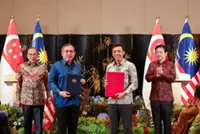Tan Bee Lian and her son, Arthur Ong, dressed as kueh tutu and ang ku kueh respectively at the Chingay parade in 2025. - ARTHUR ONG
SINGAPORE: For Chingay this year, Arthur Ong dressed up as an ang ku kueh. In his nine years as a Chingay performer, the 40-year-old technical support executive has also danced with lotus flowers, and helped to choreograph dances.
“One of my fond childhood memories was watching the Chingay performers give out candies and toys along Orchard Road in the 80s, perched on my dad’s shoulders,” said Ong, who was part of the Singapore Buddhist Federation’s contingent. “I decided then that I wanted to be a performer one day.”





